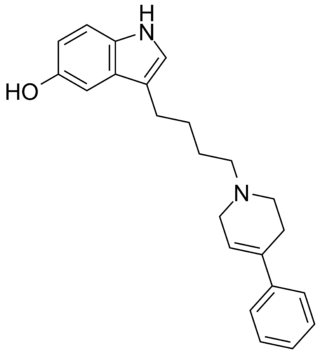
Empathogens or entactogens are a class of psychoactive drugs that induce the production of experiences of emotional communion, oneness, relatedness, emotional openness—that is, empathy or sympathy—as particularly observed and reported for experiences with 3,4-methylenedioxymethamphetamine (MDMA). This class of drug is distinguished from the classes of hallucinogen or psychedelic, and amphetamine or stimulants. Major members of this class include MDMA, MDA, MDEA, MDOH, MBDB, 5-APB, 5-MAPB, 6-APB, 6-MAPB, methylone, mephedrone, GHB, αMT, and αET, MDAI among others. Most entactogens are phenethylamines and amphetamines, although several, such as αMT and αET, are tryptamines. When referring to MDMA and its counterparts, the term MDxx is often used. Entactogens are sometimes incorrectly referred to as hallucinogens or stimulants, although many entactogens such as ecstasy exhibit psychedelic or stimulant properties as well.

5-HT receptors, 5-hydroxytryptamine receptors, or serotonin receptors, are a group of G protein-coupled receptor and ligand-gated ion channels found in the central and peripheral nervous systems. They mediate both excitatory and inhibitory neurotransmission. The serotonin receptors are activated by the neurotransmitter serotonin, which acts as their natural ligand.

Noradrenergic and specific serotonergic antidepressants (NaSSAs) are a class of psychiatric drugs used primarily as antidepressants. They act by antagonizing the α2-adrenergic receptor and certain serotonin receptors such as 5-HT2A and 5-HT2C, but also 5-HT3, 5-HT6, and/or 5-HT7 in some cases. By blocking α2-adrenergic autoreceptors and heteroreceptors, NaSSAs enhance adrenergic and serotonergic neurotransmission in the brain involved in mood regulation, notably 5-HT1A-mediated transmission. In addition, due to their blockade of certain serotonin receptors, serotonergic neurotransmission is not facilitated in unwanted areas, which prevents the incidence of many side effects often associated with selective serotonin reuptake inhibitor (SSRI) antidepressants; hence, in part, the "specific serotonergic" label of NaSSAs.

Pindolol, sold under the brand name Visken among others, is a nonselective beta blocker which is used in the treatment of hypertension. It is also an antagonist of the serotonin 5-HT1A receptor, preferentially blocking inhibitory 5-HT1A autoreceptors, and has been researched as an add-on therapy to various antidepressants, such as clomipramine and the selective serotonin reuptake inhibitors (SSRIs), in the treatment of depression and obsessive-compulsive disorder.

A serotonin receptor agonist is an agonist of one or more serotonin receptors. They activate serotonin receptors in a manner similar to that of serotonin, a neurotransmitter and hormone and the endogenous ligand of the serotonin receptors.
The 5-HT1 receptors are a subfamily of the 5-HT serotonin receptors that bind to the endogenous neurotransmitter serotonin (also known as 5-hydroxytryptamine, or 5-HT). The 5-HT1 subfamily consists of five G protein-coupled receptors (GPCRs) that share 40% to 63% overall sequence homology, including 5-HT1A, 5-HT1B, 5-HT1D, 5-HT1E, and 5-HT1F. Receptors of the 5-HT1 type, specifically, the 5-HT1A and 5-HT1D receptor subtypes, are present on the cell bodies. Receptors of the 5-HT1 type, specifically, the 5-HT1B and 5-HT1D receptor subtypes, are also present on the nerve terminals. These receptors are broadly distributed throughout the brain and are recognized to play a significant part in regulating synaptic levels of 5-HT.

The serotonin 1A receptor is a subtype of serotonin receptors, or 5-HT receptors, that binds serotonin, also known as 5-HT, a neurotransmitter. 5-HT1A is expressed in the brain, spleen, and neonatal kidney. It is a G protein-coupled receptor (GPCR), coupled to the Gi protein, and its activation in the brain mediates hyperpolarization and reduction of firing rate of the postsynaptic neuron. In humans, the serotonin 1A receptor is encoded by the HTR1A gene.

5-hydroxytryptamine receptor 1B also known as the 5-HT1B receptor is a protein that in humans is encoded by the HTR1B gene. The 5-HT1B receptor is a 5-HT receptor subtype.

AR-A000002, also known as AZD-8129, is a drug which is one of the first compounds developed to act as a selective antagonist for the serotonin receptor 5-HT1B, with approximately 10x selectivity for 5-HT1B over the closely related 5-HT1D receptor. It has been shown to produce sustained increases in levels of serotonin in the brain, and has anxiolytic effects in animal studies.

Robalzotan is a selective antagonist at the 5-HT1A receptor. It was shown to completely reverse the autoreceptor-mediated inhibition of serotonin release induced by the administration of selective serotonin reuptake inhibitors like citalopram in rodent studies. It was subsequently investigated by AstraZeneca as a potential antidepressant but like many other 5-HT1A ligands was discontinued. Later on it was researched for other indications such as irritable bowel syndrome but was dropped once again.

Serotonin antagonist and reuptake inhibitors (SARIs) are a class of drugs used mainly as antidepressants, but also as anxiolytics and hypnotics. They act by antagonizing serotonin receptors such as 5-HT2A and inhibiting the reuptake of serotonin, norepinephrine, and/or dopamine. Additionally, most also antagonize α1-adrenergic receptors. The majority of the currently marketed SARIs belong to the phenylpiperazine class of compounds.

Roxindole (EMD-49,980) is a dopaminergic and serotonergic drug which was originally developed by Merck KGaA for the treatment of schizophrenia. In clinical trials its antipsychotic efficacy was only modest but it was unexpectedly found to produce potent and rapid antidepressant and anxiolytic effects. As a result, roxindole was further researched for the treatment of depression instead. It has also been investigated as a therapy for Parkinson's disease and prolactinoma.
A serotonin modulator and stimulator (SMS), sometimes referred to more simply as a serotonin modulator, is a type of drug with a multimodal action specific to the serotonin neurotransmitter system. To be precise, SMSs simultaneously modulate one or more serotonin receptors and inhibit the reuptake of serotonin. The term was created to describe the mechanism of action of the serotonergic antidepressant vortioxetine, which acts as a serotonin reuptake inhibitor (SRI), agonist of the 5-HT1A receptor, and antagonist of the 5-HT3 and 5-HT7 receptors. However, it can also technically be applied to vilazodone, which is an antidepressant as well and acts as an SRI and 5-HT1A receptor partial agonist.

LY-393558 is a potent serotonin reuptake inhibitor and antagonist of the 5-HT1B, 5-HT1D, and 5-HT2A receptors. LY-393558 was also found to reduce serotonin-induced vasoconstriction, indicating that it may have therapeutic potential for the treatment of pulmonary hypertension.

LY-456219 is a potent and selective serotonin 5-HT1D receptor antagonist which has been used in research to study the function of presynaptic 5-HT1D autoreceptors. LY-456219 lacks significant affinity for the 5-HT1B, α1 adrenergic, and dopamine D2 receptors. It is an enantiomer of LY-456220.

LY-456220 is a potent and selective serotonin 5-HT1D receptor antagonist which has been used in research to study the function of presynaptic 5-HT1D autoreceptors. LY-456220 lacks significant affinity for the 5-HT1B, α1 adrenergic, and dopamine D2 receptors. It is an enantiomer of LY-456219.

AZD-1134 is an investigational new drug that was being evaluated for the treatment of major depressive disorder and anxiety disorder but was never marketed. It is a selective serotonin 5-HT1B receptor antagonist.














